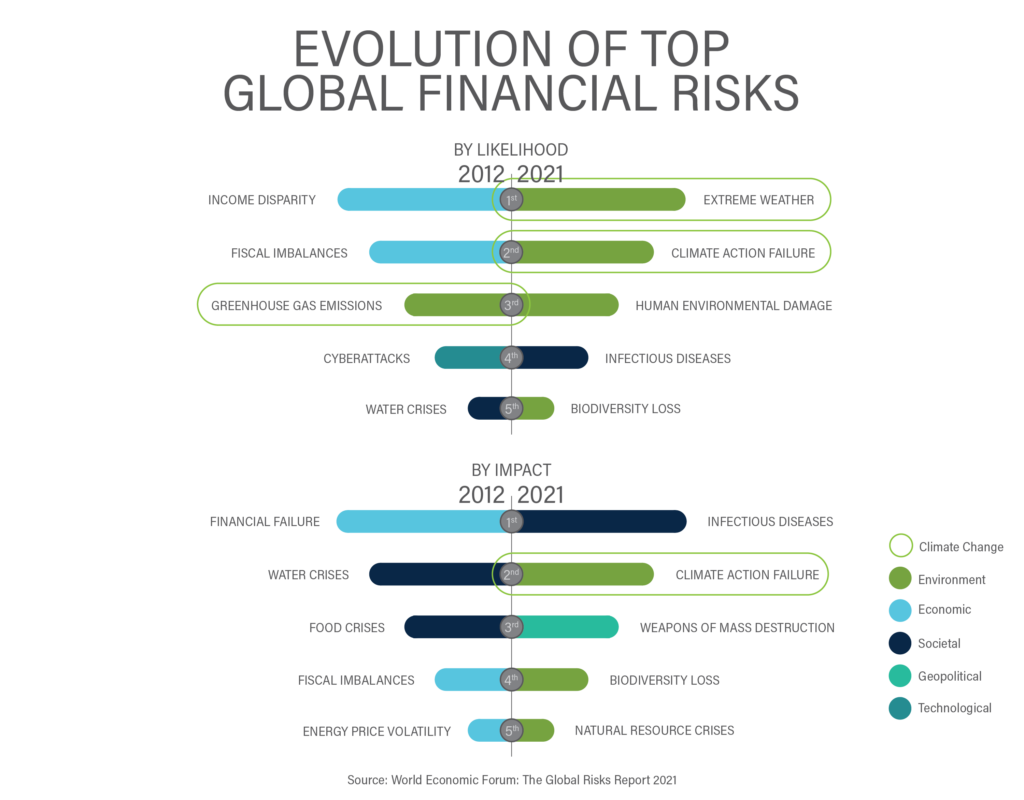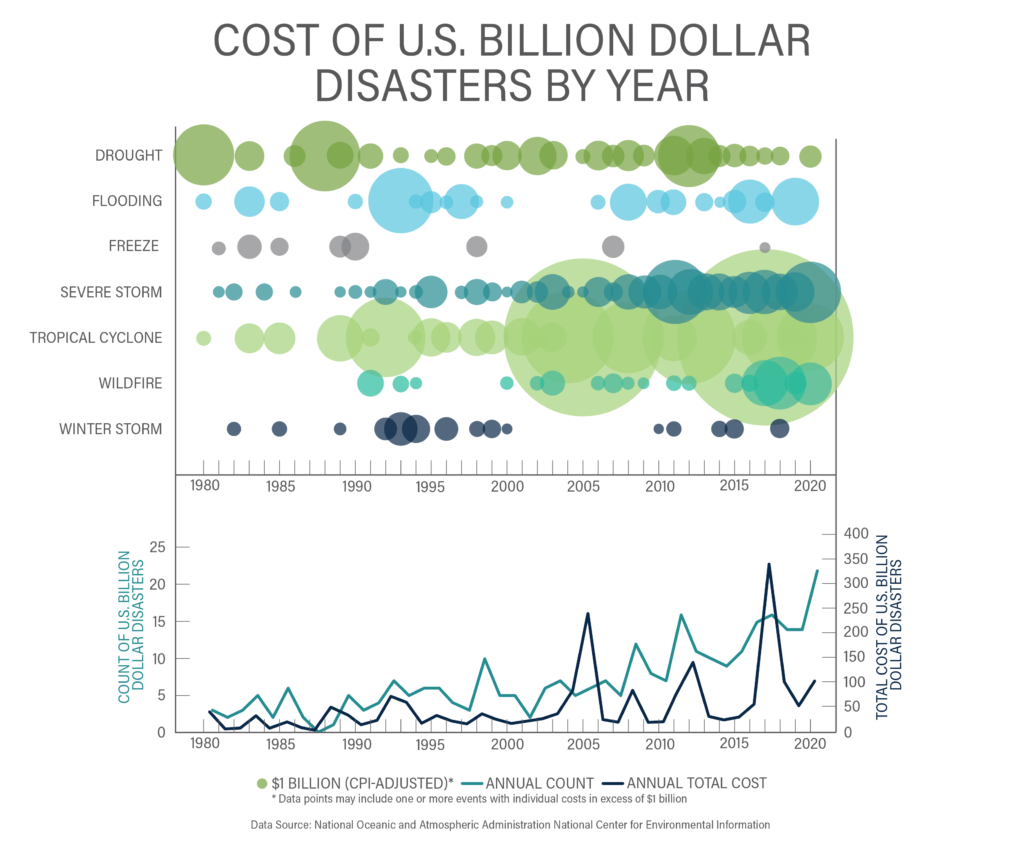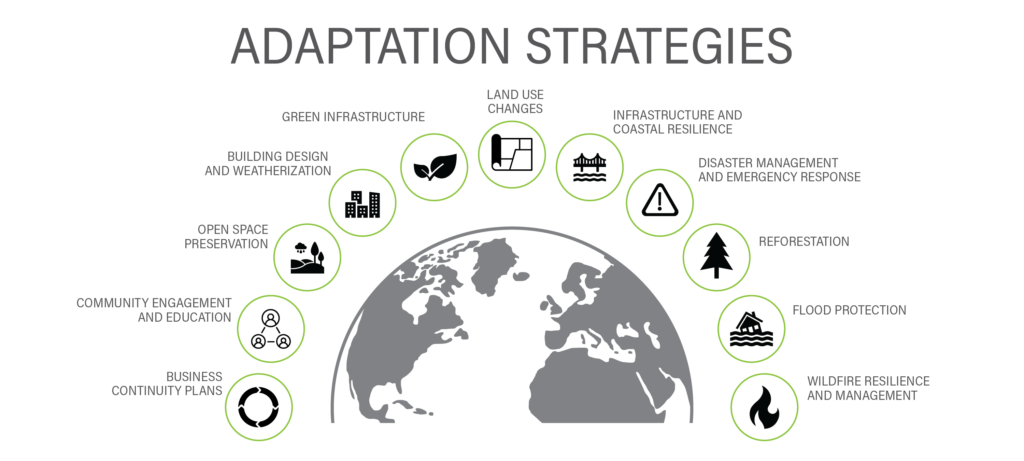The potential for human activities to cause global warming has been recognized for well over 200 years. However, the increasing frequency, duration, and intensity of extreme weather and climate events associated with that warming has led to wider recognition of the direct effects that climate change is having on our environment and infrastructure, including increased maintenance, shortened life cycles, and ballooning capital and emergency response budgets. Addressing climate change and its impacts generally requires actions that can be grouped into two categories—adaptation vs. mitigation. This thought leadership post explores the two actions and notes several EA cases-in-point in addressing these complex challenges.

The term “mitigation” has a long history of use in the environmental or natural disasters fields, where it often refers to remedial actions to reduce the impact of an event. It is often confused with “climate adaptation.” Mitigation in climate science is more proactive than reactive.
Growing recognition of the increased risk posed by changes in weather and climate extremes—flood, drought, hurricanes and tornados, heat waves and cold snaps, hailstorms, and snowstorms—is leading to significant shifts in financial and government decision making. More recently, through the lens of Environmental, Social, and Governance (ESG) and sustainability reporting frameworks, lenders and insurers are becoming more insistent that risk from these events be more fully understood, disclosed, and addressed. Government agencies responsible for public infrastructure at the federal, state, and local levels, who must maintain bond ratings or are otherwise responsible for public investments, are establishing policies to understand and reduce risk from all types of natural disasters, including those associated with extreme weather and climate change-associated events. In addition, greater attention is being focused on legal liabilities stemming from failure to acknowledge or disclose knowable risks.

Based on the World Economic Forum’s annual Global Risks Perception Survey, climate change risk has risen significantly over the last decade. In 2012, participants voted GHG emissions among the top 3 risks by likelihood, with no climate change and environmental risk present in the top 5 by impact. The latest survey results indicate extreme weather as the most likely concern, followed by climate action failure, which is also among the most impactful. Although not a direct cause of other top global financial risks, climate change is likely to exacerbate other concerns, including natural resource crises, biodiversity loss, human environmental damage, and infectious disease.
The international financial and insurance industries’ recognition of the breadth and depth of the economic disruptions that can be triggered by climate change have led the calls for debate to become calls for action. Government and private sector entities are increasingly incorporating climate risk assessments and monetization of potential impacts into both short- and long-term planning.

Time-series data from the National Oceanic and Atmospheric Administration’s (NOAA’s) National Center for Environmental Information clearly show increases over the last 30 years in the frequency in billion-dollar natural disaster events caused by drought, flooding, freeze, severe storms, wildfire, tropical cyclones, and winter storms. Costs have been adjusted for inflation using the Consumer Price Index.
Climate Change Adaptation vs Mitigation
Strategies for reducing risk from weather and climate extremes focus on either reducing the likelihood of extreme events by limiting the concentration of GHGs in the atmosphere (mitigation), by changing the way built or natural infrastructure responds to extremes events (adaptation), or both. Some GHGs, especially carbon dioxide (CO2), persist in the atmosphere for centuries. Thus, even if humanity could eliminate CO2 emissions immediately, the excess amounts in the atmosphere relative to pre-industrial times will lead to continued warming, and associated changes in climate, for the foreseeable future. This “inevitable warming” will necessitate climate adaptation. Thus, mitigation and adaptation must be carried out in parallel, as mitigating the causes of climate change will reduce both the cost of weather and climate disasters and the cost of adaptation.

Observed warming from 2010 to 2019 (relative to 1850-1900) is compared to contributions from both attribution and radiative forcing studies in the Intergovernmental Panel on Climate Change’s (IPCC) Climate Change 2021 report (link opens in a new tab). Attribution studies are based on climate models and observations, while radiative forcing studies indicate temperature change as a result of human activity.
Mitigation
Mitigating the risk of climate change through reductions of GHG emissions involves a variety of strategies including:
- Reducing use of energy based on fossil fuels
- Capturing and sequestering GHGs and other climate pollutants like black carbon before they reach the atmosphere
- Exploring methods for extracting and sequestering CO2 from the atmosphere.
Federal, state, and even some local governments, as well as private sector entities, have developed public policy or organization-specific guidelines that direct or create incentives to reduce GHG emissions. Effective implementation of these strategies often involves thorough monitoring and accounting to ensure that goals established are met.

Based on IPCC data from 2014 and published on the U.S. Environmental Protection Agency (EPA) webpage offering global data, this graphic compares emissions volumes by industry and gas.
Due to their significant contribution to radiative forcing, reducing CO2 emissions and short-lived climate pollutants is the primary goal of climate mitigation. CO2 sources vary, but their emission is dominated by the use of fossil fuels. The most obvious solution for many clients is to reduce their use of fossil fuels through energy efficiency, which yields the additional benefit of reducing energy-related expenses. Switching from coal to less carbon intensive fuels like natural gas or, better yet, renewable energy sources, can also be attractive options depending on cost and benefits. At the present time, federal guidance is evolving to respond to recent administration policy goals. Increases in incentive programs can be expected and should be considered in weighing these options.
Although methane has played less of a role in driving the observed changes in global average temperature than CO2, it is still of considerable concern and is the focus of evolving federal and state regulatory policy. While CO2 emissions account for 75-90 percent of GHG emissions on a mass basis internationally, reducing the emission of methane, which traps more heat and so has a higher global warming potential (GWP) than CO2, will be essential. This is especially true in the critical period between now and mid-century if there is to be any possibility of limiting global temperature rise to 2 degrees Celsius, as called for by the meeting of the United Nations Framework Convention on Climate Change (UNFCCC) during the recent Conference of Parties in Glasgow (COP26). Sources of methane vary, including both biological and geologic emitters. Reducing releases of methane from oil and gas operations and other anthropogenic sources is a frequent subject of federal and state regulation. Greater attention is being placed on understanding biological contributions of methane from industrial agriculture, specifically concentrated animal feeding operations where waste can be managed proactively.
In addition to reducing the emission of GHGs, climate mitigation is also addressed through efforts to increase the uptake and sequestering of carbon in various forms, thereby reducing its effect on climate. This approach can offer a variety of co-benefits as the biological uptake of carbon can increase the primary productivity of a variety of ecological systems. Several programs are in place that provide incentives for promoting carbon sequestration through managed landscapes (e.g., forests, grasslands) and are based on the social cost of carbon—a measure for monetizing the ultimate cost to society of emitting 1 metric ton of CO2 to the atmosphere. By placing a monetary value on carbon emissions, these programs can provide tax credits or other direct subsidies that reduce the cost of sequestration efforts, as well as guide regulatory development. In addition, a variety of programs world-wide promote the trade of “carbon credits,” which allow entities actively engaged in sequestration efforts to “sell” credits earned through those activities to carbon emitters. Renewable Energy Certificates (RECs), which represent the environmental attribute of 1 MWh of renewable electricity generation, are “carbon credits” used to offset carbon emissions from electricity generation. This exchange provides a pathway for many large and diverse organizations to become “net zero” carbon emitters, while providing an incentive to manage landscapes and ecosystems in a more sustainable manner. This “trade” in carbon credits or offsets has come under increased scrutiny, especially at COP26, which emphasized more direct decarbonization actions versus credit purchase. Regardless, carbon credit trading will continue to be an attractive option for organizations working to reduce their carbon footprint.
Case-in-Point
A holistic approach to mitigation should look at all aspects of operations including facility, energy, supply chain, mobility, and waste. Our team worked with a port commission to develop and finalize a comprehensive climate and air action plan that addresses administrative operations, air pollutant and GHG emissions sources, and future carbon sequestration potential. More than 40 potential strategies and proposed monitoring/reporting actions were identified.

Direct air capture (link opens in a new tab) (DAC) is a group of emerging technologies that remove CO2 directly from the atmosphere. Though still in an early stage, DAC is currently on a technology development trajectory that suggests the economies of scale needed may soon be achieved, enabling the active removal of atmospheric carbon at costs competitive with biological uptake.
Adaptation
The emission of GHGs to the atmosphere has increased substantially since the beginning of the industrial revolution and even more rapidly as energy demand grew following World War I. Consequently, the global average temperature has already increased by 1 degree Celsius (relative to the latter half of the 19th century) and is expected to increase at a greater rate over the remainder of this century and beyond. Because CO2 and methane (two of the larger drivers of global warming) are long-lived GHGs, their impact is long-lived. Regardless of any steps taken to reduce emissions, their continuing effects on the climate and related systems are inevitable. Steps to adapt to changes in the climate will be necessary to reduce their negative impacts.
Approaches to adaptation are as diverse as the human and natural systems affected. For instance, due to water’s central role in the natural and built environment, changes in the hydrologic cycle shape many impacts associated with global warming and our response to it. Sea-level rise is a major concern along most U.S. shorelines, especially in regions where geologic subsidence and rising seas combine to threaten coastal development and habitat. Sunny-day flooding (when sea-level rise and extreme high tides combine) is a phenomenon virtually unheard of 30 years ago but is now driving changes in how coastal infrastructure is designed and maintained. Shifts in inland precipitation patterns, drier in much of the West and wetter for most of the East, is changing the way crops are irrigated, forests and grasslands are managed, homes are constructed, and businesses are operated.

Climate change adaptation strategies vary greatly depending on region and threat, and often several must be combined to address specific concerns.
Changes in other aspects of climate and weather—longer and more intense heat waves, longer summers and shorter winters, more extreme swings in summer and fall storms—are also forcing adaptation in urban design, transportation systems, management of the energy grid, and nearly every other component of daily life.
Case-in-Point
A significant number of culvert and bridge crossings as well as associated infrastructure sited in tidal environments and at the transition between non-tidal, estuarine, and tidal habitats will be directly impacted by sea-level rise, especially during coastal storm events. EA worked with a state agency to enhance resilience of both natural resources and built infrastructure by developing guidance to assist in identification, prioritization, and planning of waterway-crossing replacements or modifications that are subject to sea-level rise, storm surge, and precipitation increase and intensity associated with climate change.

Next Steps
The associated risks are becoming a greater focus of the financial industry, as lenders, investors, and insurers actively consider how to limit their exposure from losses caused by weather and climate-related disasters. Change in investment strategies is a major and often overlooked component of climate adaptation.
Organizations will need to apply an integrated approach combining operations, science, engineering, and technology in order to evaluate risk and address the impacts of climate change. Tailored solutions for reducing emissions and removing GHGs from the atmosphere will begin to address causality, while cost-effective adaptation strategies increase resiliency. As the science and forecasting continue to evolve, flexibility will be necessary to address emerging challenges, including how weather and climate extremes can combine to create compound impacts (e.g., freshwater runoff combines with offshore storm surge to exceed predicted flood from either alone) or how contaminated site characterization and remediation plans should account for those changes in extremes. Alarmed by recent events or now recognizing associated operational and fiscal risks, many organizations are taking bold steps to integrate climate change strategies into their short- and long-range plans.
Further Reading
Climate.gov: Science and Information for a Climate Ready Nation is a website established by NOAA to act as “America’s public gateway to climate literacy.” This website provides access to data and analysis relevant to a variety of weather and climate products produced by NOAA, home of the National Weather Service.
EPA Climate Change has been revamped, with new content being added to the website on a regular basis. This agency website is intended to serve “as a resource to help individuals; businesses; communities; and state, local, and tribal governments access timely and accurate information about this important issue.” The site also provides access to a wide array of tools and resources intended to support both mitigation and adaptation.
International Panel on Climate Change (IPCC) provides access to a wide variety of authoritative reports and assessments. The IPCC serves as “the United Nations body for assessing the science related to climate change.” The IPCC was created to provide policymakers with regular scientific assessments on climate change, its implications, and potential future risks, as well as to put forward adaptation and mitigation options.
National Climate Assessment (US) is a Congressionally-mandated national assessment produced roughly every 5 years by 13 U.S. federal agencies that make up the U.S. Global Change Research Program (USGCRP). Each assessment is the product of hundreds of the nation’s leading experts on climate change, drawn from government, academia, and industry. By focusing on climate impacts, adaptation, and mitigation in the 50 United States, the National Climate Assessment is able to provide authoritative and relatable information about climate change.
Sabin Center for Climate Change Law is located within the Columbia Law School. The Center maintains a State and Local Climate Change Resource webpage, with active links to dozens of state and local initiatives intended to shape state and local policies, including local laws intended to reduce energy use and GHG emissions recently proliferated as part of a municipal-level response to climate change.
 5 January 2022
5 January 2022
by Dan Walker, PhD, Senior Geologist at EA and Associate Director of the Center for Technology and Systems Management within the U. of Maryland’s Department of Civil and Environmental Engineering
Contact Us
